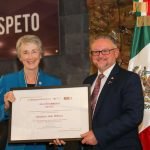Unlock the Editor’s Digest for free
Roula Khalaf, Editor of the FT, selects her favourite stories in this weekly newsletter.
When Imperial College London was founded in 1907, its mission was “to be useful”. The Massachusetts Institute of Technology was equally modest, taking the beaver as its mascot in 1914 in recognition of the dam builder’s “engineering and mechanical skill and habits of industry. His habits are nocturnal, he does his best work in the dark.”
If one drives west out of London past White City, Imperial is now impossible to miss. The science and technology university’s towering second campus, adding to its original in South Kensington, has attracted a cluster of biotechnology start-ups along with the UK head office of Novartis to a former BBC site. It is very useful to the UK economy in what has been a difficult period.
MIT has topped the QS rankings of global research universities for the past decade, and Imperial this week took second place in its 2025 table, surpassing not only Oxford and Cambridge but Harvard. From its modest roots in a merger involving the Royal College of Chemistry and Royal School of Mines, it is one of the world’s fastest expanding and most prized universities.
University rankings should be taken with a large pinch of sodium chloride, of course. Averaging out many factors, including teaching quality, the employability of graduates and research influence will always lead to arbitrary results, never mind the game playing that goes on. Even the fact that Imperial rose four places this year has limited significance in itself.
But there is no question that Imperial has thrived since divorcing from the University of London nearly two decades ago. It has 23,000 students, nearly half from overseas despite those undergraduates paying between £38,000 and £54,000 annually. Their focus on hardcore subjects in science, technology, engineering, medicine and business makes them sought-after graduates.
Behind this lies a larger story about the global growth of science and technology universities, many created as second-tier vocational institutions centuries after the liberal arts and humanities colleges that are most often identified with the word “university”. The takeover of many industries by Silicon Valley’s technology is reflected in the world of education.
MIT and the California Institute of Technology (Caltech) made the transition some time ago. But others in Europe and Asia are coming up. A steady presence in the QS top 10 is ETH Zurich, the university where Albert Einstein was a professor, despite having been a mediocre student there.
Their ranking is a belated fulfilment of what the educationalist John Dewey foresaw in 1944 in a seminal essay on liberal arts education. He wrote that the 19th-century divide between elite and vocational education was outdated amid a scientific revolution “breaking down once and for all the wall between the hand and the head”.
Study of physics, computing, aeronautical engineering and life sciences ranges from the purest research to applications and skills that have become essential in many jobs, from finance to drug development. Imperial’s first mission was not just whimsy — vocational skills were once called the “useful arts” — but PhDs in science are now vocational.
Universities such as MIT, Imperial and ETH are plainly not the only ones that educate students in science and technology. Silicon Valley draws its intellectual heft from Stanford University, which offers many other courses than computer science. Cambridge university’s strength in life sciences also makes it a business magnet.
But focus can bring clarity to an institution. Hugh Brady, president of Imperial, tells me he was struck by the attitude of many of its students when he arrived from Bristol University two years ago. “They are interested in innovation and many of them will say, even at open days, that they want to start a company when they leave.”
The high-level practicality and convening power of top scientific universities mean their prestige and importance to economies is growing. That in turn makes it vital for the countries in which they are based to keep cultivating them: the wider UK higher education sector is under financial pressure, with more than half its universities falling in the QS rankings.
One difficulty is that science courses require laboratory space and are costly to provide: Brady estimates that Imperial loses an average of £4,000 a year for every UK undergraduate paying the UK tuition fee of £9,250. Like others, it makes up for this by charging the overseas students more, and by attracting funding for its highly rated research.
Top US institutions are wealthier, while most of ETH’s funding comes directly from the Swiss government rather than student fees. There is a danger of the UK, which has many prominent global universities thanks to history, falling between the two stools. Imperial has made its financial formula work, but it might not always do so.
Still, I would not bet against Imperial and other scientific universities continuing to gain on their ivory-towered competitors. It was once easy to look down on them, but we should look up.










